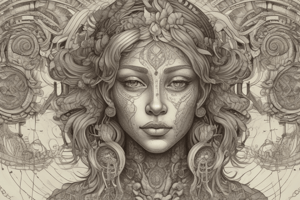Podcast
Questions and Answers
What are derived traits?
What are derived traits?
Derived traits are those that just appeared (by mutation) in the most recent ancestor.
What are ancestral traits?
What are ancestral traits?
Traits inherited from distant ancestors.
What is a homologous structure?
What is a homologous structure?
An organ or bone that appears in different animals, demonstrating descent from a common ancestor.
What is gametic isolation?
What is gametic isolation?
What is hybrid infertility?
What is hybrid infertility?
What is an adaptation?
What is an adaptation?
What is artificial selection?
What is artificial selection?
What is directional selection?
What is directional selection?
What is speciation?
What is speciation?
What is sympatric speciation?
What is sympatric speciation?
What are vestigial structures?
What are vestigial structures?
What is mechanical isolation?
What is mechanical isolation?
What is an analogous structure?
What is an analogous structure?
What is natural selection?
What is natural selection?
What is sexual selection?
What is sexual selection?
What is selective pressure?
What is selective pressure?
What is stabilizing selection?
What is stabilizing selection?
What is disruptive selection?
What is disruptive selection?
What is allopatric speciation?
What is allopatric speciation?
What is temporal isolation?
What is temporal isolation?
What is behavioral isolation?
What is behavioral isolation?
Flashcards are hidden until you start studying
Study Notes
Key Biological Terms and Definitions
- Derived Traits: Traits that are newly appeared due to mutations in the most recent ancestor, leading to a new evolutionary branch.
- Ancestral Traits: Traits inherited from distant ancestors, distinguishing them from derived traits.
- Homologous Structures: Organs or bones in different animals that demonstrate anatomical similarities, indicating a shared common ancestor.
- Gametic Isolation: A prezygotic barrier where gametes come into contact but do not fertilize.
- Hybrid Infertility: Occurs when hybrid offspring, although developing normally, are sterile and cannot produce viable gametes. Example: mules (horse-donkey cross).
- Adaptation: Genetic mutations or changes that enhance an organism's survival in its environment.
- Artificial Selection: Deliberate breeding of individuals with desirable traits to promote certain characteristics within a population.
- Directional Selection: A natural selection process that favors extreme phenotypes over others, shifting the population mean.
Evolution and Speciation Processes
- Speciation: The process through which new and distinct species evolve from a common ancestor.
- Sympatric Speciation: Evolution of new species from a single ancestral species while cohabiting the same geographical area.
- Vestigial Structures: Anatomical features that serve no significant function, remnants of ancestors.
- Mechanical Isolation: Reproductive barriers that prevent mating between different species due to biological features.
- Analogous Structures: Structures in different species that share similar functions but evolved separately; no common ancestry.
Mechanisms of Natural Selection
- Natural Selection: Differential survival and reproduction based on phenotypic differences, a core mechanism of evolution.
- Sexual Selection: A form of natural selection driven by preference of one sex for specific traits in the other sex.
- Selective Pressure: Factors that reduce reproductive success in part of a population, thereby influencing evolutionary change.
- Stabilizing Selection: Type of natural selection that keeps the population mean stable around a non-extreme trait value.
- Disruptive Selection: Selection favoring extreme trait values over intermediate ones, increasing trait variance and creating distinct population groups.
Isolation Mechanisms
- Allopatric Speciation: Occurs when populations of the same species become geographically isolated, preventing genetic interchange.
- Temporal Isolation: Mechanism preventing species from mating due to differences in timing of reproductive periods.
- Behavioral Isolation: Occurs when two species do not mate due to differences in courtship behaviors, also known as ethological isolation.
Studying That Suits You
Use AI to generate personalized quizzes and flashcards to suit your learning preferences.




